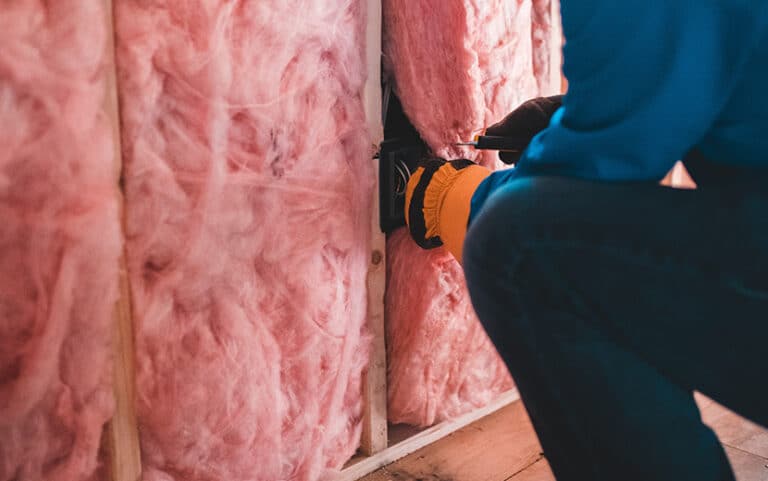The Ultimate Guide to Roof Insulation: Types, Installation, and Benefits
Aug 16, 2023
The Ultimate Guide to Roof Insulation: Types, Installation, and Benefits
Effective insulation is a crucial aspect of any property’s overall comfort, energy efficiency, and long-term value. Roof insulation, in particular, plays a vital role in maintaining a comfortable indoor temperature, reducing energy consumption, and enhancing the performance of your HVAC system. In this comprehensive guide, we will explore the various types of roof insulation available, their benefits, and the process of installation. Additionally, we will highlight how the experienced professionals at Honey Bees Roofing & Solar can guide you on choosing the right insulation for your property and provide expert installation services.
Roofs are typically insulated in two main ways: by insulating the attic floor (known as “cold roof” insulation) or by insulating directly beneath the roof deck (referred to as “warm roof” insulation). Each method has its advantages and disadvantages, and the choice ultimately depends on factors such as climate, construction type, and budget. Regardless of the method used, proper roof insulation can yield numerous benefits, including reduced heat transfer between the interior and exterior, enhanced energy efficiency, prevention of ice dams, and improved indoor air quality.
When selecting the appropriate insulation material for your roof, it’s crucial to consider factors like the insulating property (R-value), ease of installation, resistance to moisture, and environmental impact. Popular insulation materials include fiberglass, mineral wool, spray foam, cellulose, and foam board.
At Honey Bees Roofing & Solar, we understand the significance of proper roof insulation, and we are dedicated to offering professional advice, high-quality materials, and expert installation services to our clients. Our roofing specialists possess the knowledge and experience needed to help you make informed decisions about your insulation needs and deliver a solution tailored to your property’s unique requirements. By partnering with us, you can rest assured that your roof insulation project will be handled with care, providing lasting benefits for your property and anyone living there.
In the following sections, we will delve deeper into the various types of roof insulation, the installation process, and the advantages of investing in insulation. We will also provide insights into how Honey Bees Roofing & Solar can make your roof insulation project easier, ensuring you achieve superior comfort and energy efficiency for your property.
Understanding Different Types of Roof Insulation
There are various insulation materials available, each with its unique properties and benefits. Let’s take a closer look at some popular roof insulation options:
- Fiberglass: Made from fine glass fibers, fiberglass insulation is lightweight and easy to install. It is available in rolls or batts and provides excellent thermal resistance with a high R-value per inch. However, it can be less effective if exposed to moisture, making it crucial to ensure proper installation and moisture control.
- Mineral Wool: This type of insulation is made from molten rock or slag wool, providing excellent thermal and sound insulation. It is also fire-resistant and won’t be affected by moisture. However, mineral wool can be more expensive than other insulation materials like fiberglass.
- Spray Foam: Spray foam insulation is applied by spraying a liquid foam directly onto surfaces, filling gaps and cracks. Once the foam expands and hardens, it offers superior insulation and air sealing. This type of insulation can be either open-cell or closed-cell, with closed-cell being more energy-efficient but more expensive than open-cell.
- Cellulose: Made from recycled paper or wood fibers, cellulose insulation is an environmentally-friendly option. It provides excellent thermal performance and also has sound-dampening qualities. However, cellulose insulation can be more susceptible to moisture and may require an additional vapor barrier.
- Foam Board: Comprised of rigid foam panels, foam board insulation offers high R-values and excellent moisture resistance. It can be used in both cold and warm roof insulation applications but may require specialized cutting tools for proper fitting and installation.
Choosing Between Cold Roof and Warm Roof Insulation
As mentioned earlier, there are two primary methods of insulating a roof: cold roof insulation and warm roof insulation. Each has its advantages and is suitable for different situations:
- Cold Roof Insulation: This method involves installing insulation material on the attic floor, thereby insulating the living space below from the cold attic. Cold roof insulation is simpler and less expensive than warm roof insulation, making it a popular choice for retrofitting existing properties. However, it requires good ventilation to prevent moisture buildup and potential condensation issues in the attic.
- Warm Roof Insulation: In this method, insulation is placed directly beneath the roof deck, creating a warm, insulated space within the attic. Warm roof insulation is particularly suitable for properties with inhabited attics, flat roofs, or complex roof designs. It also minimizes the risk of condensation and ice dams, as the entire attic space is kept at a stable temperature. However, warm roof insulation can be more challenging and costly to install, especially in retrofit projects.
The Roof Insulation Installation Process
The process of insulating a roof will vary depending on the type of insulation chosen and whether it is a new construction or a retrofit project. In general, here is what you can expect during the installation process:
- Assess your needs: Consult with a professional roofing contractor like Honey Bees Roofing & Solar to evaluate your property’s insulation requirements and determine the most suitable materials and method for your project.
- Prepare the area: Before beginning installation, the work area should be cleaned, and any necessary repairs or surface preparations should be carried out, such as sealing air leaks or installing a vapor barrier.
- Install insulation: Based on the insulation type and method chosen, the material will be installed according to manufacturer specifications and building codes. Proper installation is crucial to ensure the effectiveness and longevity of the insulation.
- Inspect and seal: Once the insulation is in place, a thorough inspection should be conducted to ensure that there are no gaps or other issues that could compromise the insulation’s performance. Any additional sealing or finishing work should be carried out to complete the installation.
Benefits of Investing in Roof Insulation
Investing in proper roof insulation can offer numerous advantages for your property and its occupants:
- Increased energy efficiency: Properly insulated roofs help reduce heat transfer between the interior and exterior, resulting in lower energy consumption and reduced utility bills.
- Enhanced comfort: Insulation can help maintain stable indoor temperatures, creating a more comfortable living environment year-round.
- Extended roof lifespan: By preventing ice dams and reducing thermal stress on roofing materials, insulation can improve the longevity of your roof.
- Improved sound insulation: Some insulation materials also have sound-dampening properties, reducing exterior noise and creating a quieter indoor environment.
Conclusion
Roof insulation is an essential component of any property, offering numerous benefits such as energy efficiency, comfort, and an extended roof lifespan. By understanding the different types of roof insulation, choosing between cold and warm roof insulation, and ensuring the proper installation process, you can enhance the performance and value of your property. The experienced team at Honey Bees Roofing & Solar is ready to assist you in selecting the right insulation solution for your needs and providing expert Burleson roof installation services. Contact us today to learn more about how we can help improve your property’s comfort, energy efficiency, and overall well-being.
